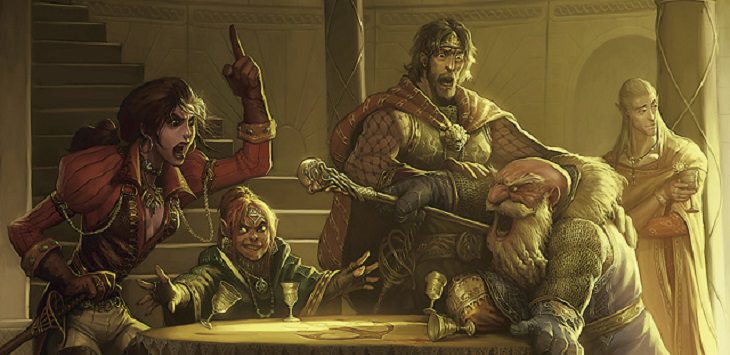Five D&D Creatures That Punch Above Their Challenge Rating

A huge part of being a Dungeon Master is choosing monsters for the players to face. Although combat encounters can occur that the DM didn’t expect, usually the DM takes time to craft an encounter. They try to create a challenging, yet fun session for the players.
The Dungeon Master’s Guide and Monster Manual explain how to calculate an encounter using the monster’s challenge rating (CR). You can also calculate it based on the amount of experience points a monster has. However, since a monster’s XP is based on its challenge rating (p. 9 MM), it’s easier to use the CR.
As any experienced DM will tell you…the CR is merely one factor out of many. Other factors include: the number of PCs, their tactical skill, the last time the characters took a long rest, the equipment they have, the number of NPC allies, the monster’s allies, and the monster’s tactical skill. It is very possible for a battle that should have been a challenge to end up a push over, while a supposedly “medium” encounter turns into a bloodbath.
Case in point, here are five creatures with a CR of less than 1 that punch above their challenge rating.
Rust monster
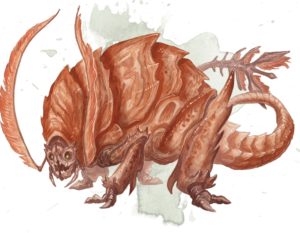 First on our alphabetically ordered list is the rust monster. This medium-sized monstrosity clocks in at CR ½ . It’s bonus to hit (+3) is modest, and its average damage output (5) is pretty good. However, the rust monster doesn’t care about killing the players. The rust monster’s strength lies in its name: it can rust nonmagical metal. And that makes it a big problem for adventurers.
First on our alphabetically ordered list is the rust monster. This medium-sized monstrosity clocks in at CR ½ . It’s bonus to hit (+3) is modest, and its average damage output (5) is pretty good. However, the rust monster doesn’t care about killing the players. The rust monster’s strength lies in its name: it can rust nonmagical metal. And that makes it a big problem for adventurers.
Rust monsters eat ferrous metals, such as iron, steel, adamantine, and even mithral (p. 262 MM). Although they typically spend their days crawling underground in search of those scrumptious metals, a low-level party of adventurers, with all their (probably nonmagical) equipment is a walking smorgasbord. A rust monster can pinpoint, by scent, the location of ferrous metal within 30 feet of it. They’ll be on our heroes like ants on a picnic.
Now this is where things get tasty (for the rust monster). Any nonmagical weapon made of metal that hits the rust monster corrodes, taking a permanent and cumulative penalty to damage rolls. If its penalty drops below -5, the weapon is destroyed (p. 262 MM). If that weren’t bad enough, a rust monster can also use its action to touch an object that it can see within five feet of it with its antennae – instantly corroding it. A Dexterity saving throw may prevent a character’s equipment from being rusted, but the character with the lowest Dexterity is probably the one with the most metal armor.
Rust monsters are rarely found in large groups. This can lure adventurers into a false sense of security. (“Oh, it’s only three giant bug things – no problem! We’ve handled double the amount of giant wolf spiders, and those are way scarier….Ah! My sword!”). Even if the party kills the rust monsters before their weapons and armor are destroyed, they will still be at a disadvantage until they get new ones. Creative characters might sacrifice other metal objects to lure the creatures away or make do with substandard equipment looted from whatever other creatures they face.
This makes rust monsters a great threat to add in the middle of a dungeon crawl – too deep to go back for new equipment, but still more things to fight ahead. In fact, it explicitly states in the write up that rust monsters often become friendly companions or pets to other Underdark denizens. So, using rust monsters as minions of a stronger, intelligent creature could make for a unique encounter.
Sahuagin
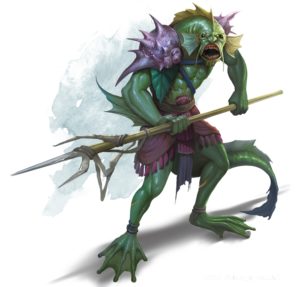 Next on the list (and the pages of the Monster Manual) is the sahuagin. These fish people with a frightful name (pronunciation according to Chris Perkins here) seem at first glance to be pretty standard baddies, just for water adventures. They are CR ½, and all their attacks deal 5 damage or less on average.
Next on the list (and the pages of the Monster Manual) is the sahuagin. These fish people with a frightful name (pronunciation according to Chris Perkins here) seem at first glance to be pretty standard baddies, just for water adventures. They are CR ½, and all their attacks deal 5 damage or less on average.
A closer look at their stat block, however, reveals that sahuagin are no joke. First, they have multiattack. The two attacks per round will, of course, double their potential damage output. However, their multiattack, although rare at this CR and something to keep in mind, is small fry compared to two of their features: Blood Frenzy and Shark Telepathy.
The two features go hand in hand and make great thematic sense. The sahuagin have a unique tie to sharks, which they can command using telepathy. Also, they – like sharks – are worked into a frenzy at the scent of blood. Their Blood Frenzy feature grants the sahuagin advantage on melee attack rolls against any creature that doesn’t have all its hit points.
Sahuagin are not dumb. They have an above average Intelligence score of 12 (+1). They know they are stronger when their enemies have taken damage. Working together, they could make sure every member of the party was wounded before swarming together for the kill. From a game mechanics standpoint, advantage on every melee attack is HUGE. The more they roll, the more likely they are to hit (or critically hit). Combine that with their shark minions (aka water wolves), and you could easily have a TPK on your hands.
Shadows
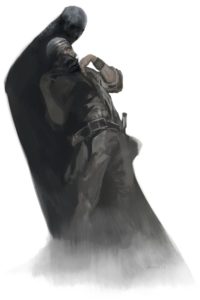 The shadow is a classic monster. It’s the embodiment of dread – the creeping darkness, death made physical. Shadows can fit into almost any encounter (and – with their amorphous ability – through almost any space). They are CR 1/2, like our other two monsters on the list so far. Their damage output is above average, but it’s their special ability and defenses that make these monsters so tough.
The shadow is a classic monster. It’s the embodiment of dread – the creeping darkness, death made physical. Shadows can fit into almost any encounter (and – with their amorphous ability – through almost any space). They are CR 1/2, like our other two monsters on the list so far. Their damage output is above average, but it’s their special ability and defenses that make these monsters so tough.
Shadows are resistant to almost every type of damage, even magical damage such as fire and cold, the staple damage types of most casters. They’re completely immune to necrotic and poison damage, and to basically every condition. The flip side of these amazing defenses is their vulnerability to radiant damage and their weakness to sunlight.
I should hope that no self-respecting DM will ever use shadows in broad daylight, so their sunlight weakness, while thematically appropriate, will rarely be a factor. What will be used, and, with a tactical minded DM, be used to deadly effect, is their shadow stealth feature. While the shadow is in dim light or darkness (aka…the only places you would ever have shadows), they are able to Hide as a bonus action. A shadow willing to risk an opportunity attack could slither in, attack, move away from the adventurer’s light source, and then blend into the shadows, which would give it advantage on its next round.
An even trickier tactic would be for the shadows to stealth toward a group of intrepid heroes, attack, and then move away to Hide. Since their opponents are Surprised, they won’t be able to make opportunity attacks (unless the PCs are lucky with their initiative order or aren’t Surprised).
Other monsters have Hide abilities, so what sets the shadows apart from, say, a goblin, is their innate weapon attack: Strength Drain. Every single attack that the shadow lands saps away some of their victim’s Strength. Characters lose 1d4 to their total Strength score, and a creature that has their Strength score reduced to 0…dies. No saving throw, no way to heal them. Dead.
A character with a low Strength score assaulted by shadows is in grave danger. Even a character with a high score could struggle. They may be better equipped to survive, but each time their Strength is drained, it chips away at their ability to hit and the damage they are able to deal against the shadows. That combined with the shadows many damage resistances can tip a fight very quickly into a downward spiral.
Swarms
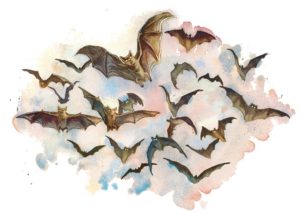 More tiny beasts…more problems for adventurers. I suppose anything could be a swarm, but this is discussing the different insect and tiny beast swarms in the Monster Manual (p. 338-339). The bats, rats, and ravens are all CR ¼, whereas the different insects are CR ½. The insect swarms do a little more damage and have special movement abilities, which bumps them up a CR level.
More tiny beasts…more problems for adventurers. I suppose anything could be a swarm, but this is discussing the different insect and tiny beast swarms in the Monster Manual (p. 338-339). The bats, rats, and ravens are all CR ¼, whereas the different insects are CR ½. The insect swarms do a little more damage and have special movement abilities, which bumps them up a CR level.
The damage output for the swarms is significant for their level, especially for the insects. However, their attack bonus is at or below average, and their damage drops in half once the swarm is at half its hit points.
The swarm’s strength lies in its ability to soak damage and confound their opponents. Since a swarm is made of lots of tiny beasts, the “swarm” is resistant to bludgeoning, piercing, and slashing damage and immune to most conditions. For low level characters, especially groups who rely heavily on physical attacks, a swarm’s damage resistances essentially double their hit point total. It makes them the enemy that just…won’t…die.
My favorite trait of swarms is their ability to occupy another creature’s space. In fact, they must occupy another creature’s space in order to attack their target. Players might assume that if they attack the swarm there is a good chance they will hurt their ally or themselves. This can lead to fun shenanigans as the PCs attempt to get the swarm away from them in other ways. According to D&D 5e RAW (rules as written), there is no risk of harming your allies when you attack a swarm that is occupying the same space as your ally. However, the DM is free to rule that in a logical way. Maybe they have disadvantage on the attack; maybe the swarm gains a +2 bonus to AC for half cover; or maybe something only happens if the attacking character rolls a critical failure.
Wolves & Worgs
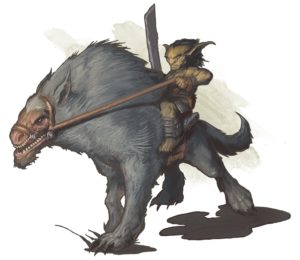 Last on this list, but certainly not least, are two tough canines – the wolf and the worg. They’re grouped together because, based on their stat blocks, a worg is just a larger, more powerful wolf, but still meets our criteria of being less than CR 1. Wolves are CR ¼ and worgs are CR ½. Their attack bonuses and damage outputs are solid, but that is not what got them a place on this list.
Last on this list, but certainly not least, are two tough canines – the wolf and the worg. They’re grouped together because, based on their stat blocks, a worg is just a larger, more powerful wolf, but still meets our criteria of being less than CR 1. Wolves are CR ¼ and worgs are CR ½. Their attack bonuses and damage outputs are solid, but that is not what got them a place on this list.
Wolves have the pack tactics feature. This allows them to have advantage on attack rolls against a creature if one of their allies is adjacent to the same creature. As with the sahuagin, advantage on attacks is very significant in an encounter. It goes a long way to increasing the odds that their attacks will land, and therefore the amount of overall damage each monster will deal. Although worgs don’t have the pack tactics feature, they’re smart (enough that they have their own language), so they can coordinate with each other on attacks. If your game uses the optional flanking rules, worgs will absolutely attempt to position themselves in flanking positions.
These beasts are fast – wolves with a 40ft speed and worgs with a 50ft movement speed. They will use their superior speed to get into those advantageous positions against their foes, or to get away from dangerous ones. They may also dart away from the main group to attack the ranged spellcaster or fighter causing trouble on the back line, and then run away before the tough melee fighters can engage with them.
The other thing that sets these canines apart is that their standard attack action includes the possibility that their target is knocked prone. A target must succeed on a Strength saving throw when they are hit, or they are knocked over. The Prone condition is not one an adventurer wants to be in when they are surrounded by a pack of hungry wolves.
Both wolves and worgs are smart enough to work as a cohesive pack. They’ll gang up on one target, hoping that each attack either deals a lot of damage or knocks them prone. If they can knock their opponent prone early on, then that sets up their pack for even more damage potential. All melee attacks within 5 feet of a prone target have advantage. The character will suffer disadvantage on all their attacks unless they spend half their movement to stand, which makes it even less likely they’ll get away from the speedy pack.
Conclusion
A monster’s challenge rating is a good starting point when planning an encounter, but it’s not able to predict the outcome. A well-rested, tactically minded group can breeze through what on paper should be deadly, while a series of bad decisions (or just bad rolls) can shift an encounter from easy to hard.
The way a DM plays the creatures also makes a big difference. Do they use their abilities to their best advantage? Tactics matter. In the examples above, those monsters are only deadly if they fight strategically. A great resource for DMs is Keith Ammann’s website (and book!), The Monsters Know What They’re Doing. I highly encourage ever DM to check it out. You’re already outnumbered by your players; you need every advantage you can get. Just be careful with those sneaky monsters like the ones here that can really pack a punch if used effectively.


